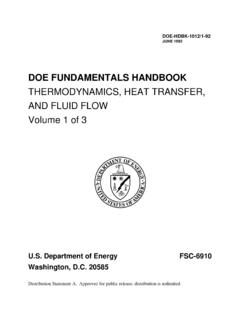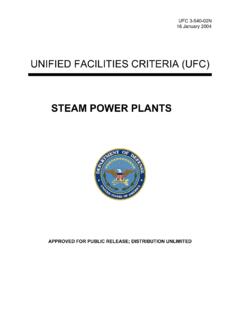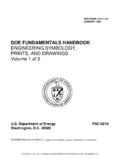Transcription of DOE-HDBK-1019/1-93; DOE Fundamentals Handbook …
1 DOE-HDBK-1019/1-93 JANUARY 1993 DOE Fundamentals HANDBOOKNUCLEAR PHYSICSAND REACTOR THEORYV olume 1 of department of EnergyFSC-6910 Washington, 20585 Distribution Statement A. Approved for public release; distribution is document has been reproduced directly from the best available to DOE and DOE contractors from the Office of Scientific andTechnical Information. Box 62, Oak Ridge, TN to the public from the National Technical Information Services, of Commerce, 5285 Port Royal., Springfield, VA No. DE93012221 DOE-HDBK-1019/1-93 nuclear physics AND REACTOR THEORYABSTRACTThe N uclear physics and Reactor Theory Handbook was developed to assist nuclearfacility operating contractors in providing operators, maintenance personnel, and the technicalstaff with the necessary Fundamentals training to ensure a basic understanding of nuclear physicsand reactor theory.
2 The Handbook includes information on atomic and nuclear physics ; neutroncharacteristics; reactor theory and nuclear parameters; and the theory of reactor operation. Thisinformation will provide personnel with a foundation for understanding the scientific principlesthat are associated with various DOE nuclear facility operations and Words: Training Material, Atomic physics , The Chart of the Nuclides, Radioactivity,Radioactive Decay, Neutron Interaction, Fission, Reactor Theory, Neutron Characteristics,Neutron Life Cycle, Reactor KineticsRev. 0 NPDOE-HDBK-1019/1-93 nuclear physics AND REACTOR THEORYFOREWORDThe Departm ent of energy (DOE) Fundam entals Handbooks consist of ten academicsubjects, which include Mathematics; Classical physics ; Thermodynamics, Heat Transfer, andFluid Flow; Instrumentation and Control; Electrical Science; Material Science; MechanicalScience; Chemistry; Engineering Symbology, Prints, and Drawings; and nuclear physics andReactor Theory.
3 The handbooks are provided as an aid to DOE nuclear facility handbooks were first published as Reactor Operator Fundamentals Manuals in 1985for use by DOE category A reactors. The subject areas, subject matter content, and level ofdetail of the Reactor Operator Fundamentals Manuals were determined from several Category A reactor training managers determined which materials should be included, andserved as a primary reference in the initial development phase. Training guidelines from thecommercial nuclear power industry, results of job and task analyses, and independent input fromcontractors and operations-oriented personnel were all considered and included to some degreein developing the text material and learning DOE Fundam entals Handbooks represent the needs of various DOE nuclear facilities'fundamental training requirements.
4 To increase their applicability to nonreactor nuclear facilities,the Reactor Operator Fundamentals Manual learning objectives were distributed to the NuclearFacility Training Coordination Program Steering Committee for review and comment. To updatetheir reactor-specific content, DOE Category A reactor training managers also reviewed andcommented on the content. On the basis of feedback from these sources, information that appliedto two or more DOE nuclear facilities was considered generic and was included. The final draftof each of the handbooks was then reviewed by these two groups. This approach has resultedin revised modular handbooks that contain sufficient detail such that each facility may adjust thecontent to fit their specific Handbook contains an abstract, a foreword, an overview, learning objectives, and textmaterial, and is divided into modules so that content and order may be modified by individualDOE contractors to suit their specific training needs.
5 Each Handbook is supported by a separateexamination bank with an answer DOE Fundam entals Handbooks have been prepared for the Assistant Secretary forNuclear energy , Office of nuclear Safety Policy and Standards, by the DOE TrainingCoordination Program. This program is managed by EG&G Idaho, 0 NPDOE-HDBK-1019/1-93 nuclear physics AND REACTOR THEORYOVERVIEWThe Departm ent of energy Fundam entals Handbook entitled N uclear physics and ReactorTheory was prepared as an information resource for personnel who are responsible for theoperation of the department 's nuclear facilities. Almost all processes that take place in a nuclearfacility involves the transfer of some type of energy . A basic understanding of nuclear physicsand reactor theory is necessary for DOE nuclear facility operators, maintenance personnel, andthe technical staff to safely operate and maintain the facility and facility support systems.
6 Theinformation in this Handbook is presented to provide a foundation for applying engineeringconcepts to the job. This knowledge will help personnel understand the impact that their actionsmay have on the safe and reliable operation of facility components and N uclear physics and Reactor Theory Handbook consists of four modules that arecontained in two volumes. The following is a brief description of the information presented ineach module of the 1 of 2 Module 1 - Atomic and nuclear PhysicsIntroduces concepts of atomic physics including the atomic nature of matter, thechart of the nuclides, radioactivity and radioactive decay, neutron interactions andfission, and the interaction of radiation with 2 - Reactor Theory ( nuclear Parameters)Provides information on reactor theory and neutron characteristics.
7 Includes topicssuch as neutron sources, neutron flux, neutron cross sections, reaction rates,neutron moderation, and prompt and delayed 0 NPDOE-HDBK-1019/1-93 nuclear physics AND REACTOR THEORYOVERVIEW (Cont.)Volume 2 of 2 Module 3 - Reactor Theory ( nuclear Parameters)Explains the nuclear parameters associated with reactor theory. Topics include theneutron life cycle, reactivity and reactivity coefficients, neutron poisons, andcontrol rods. Module 4 - Reactor Theory (Reactor Operations)Introduces the reactor operations aspect of reactor theory. Topics includesubcritical multiplication, reactor kinetics, and reactor operation. The information contained in this Handbook is not all-encompassing. An attempt topresent the entire subject of nuclear physics and reactor theory would be impractical.
8 However,the N uclear physics and Reactor Theory Handbook presents enough information to provide thereader with the fundamental knowledge necessary to understand the advanced theoretical conceptspresented in other subject areas, and to understand basic system and equipment 0 NPDepartment of EnergyFundamentals HandbookNUCLEAR physics AND REACTOR THEORYM odule 1 Atomic and nuclear PhysicsAtomic and nuclear PhysicsDOE-HDBK-1019/1-93 TABLE OF CONTENTSTABLE OF CONTENTSLIST OF FIGURES .. ivLIST OF TABLES .. vREFERENCES .. viOBJECTIVES .. viiATOMIC NATURE OF 1 Structure of Matter .. 1 Subatomic Particles .. 2 Bohr Model of the Atom .. 3 Measuring Units on the Atomic Scale .. 4 Nuclides .. 4 Isotopes .. 6 Atomic and nuclear Radii .. 6 nuclear Forces .. 7 Summary .. 9 CHART OF THE NUCLIDES.
9 11 Chart of the 11 Information for Stable Nuclides .. 13 Information for Unstable Nuclides .. 13 Neutron - Proton Ratios .. 14 Natural Abundance of 15 Enriched and Depleted Uranium .. 15 Summary .. 16 MASS DEFECT AND BINDING 17 Mass Defect .. 17 Binding energy .. 18 energy Levels of Atoms .. 19 energy Levels of the Nucleus .. 20 Summary .. 21 Rev. 0 Page iNP-01 TABLE OF CONTENTSDOE-HDBK-1019/1-93 Atomic and nuclear PhysicsTABLE OF CONTENTS (Cont.)MODES OF RADIOACTIVE DECAY .. 22 Stability of 22 Natural Radioactivity .. 22 nuclear 23 Alpha Decay ( ) .. 24 Beta Decay ( ) .. 24 Electron Capture (EC, K-capture) .. 25 Gamma Emission ( ) .. 26 Internal 26 Isomers and Isomeric Transition .. 26 Decay 27 Predicting Type of 27 Summary .. 29 RADIOACTIVITY.
10 30 Radioactive Decay 30 Units of Measurement for 31 Variation of Radioactivity Over Time .. 31 Radioactive Half-Life .. 32 Plotting Radioactive 35 Radioactive 38 Transient Radioactive 40 Summary .. 41 NEUTRON INTERACTIONS .. 43 Scattering .. 43 Elastic 43 Inelastic Scattering .. 45 Absorption Reactions .. 46 Radiative Capture .. 46 Particle Ejection .. 46 Fission .. 46 Summary .. 47NP-01 Page iiRev. 0 Atomic and nuclear PhysicsDOE-HDBK-1019/1-93 TABLE OF CONTENTSTABLE OF CONTENTS (Cont.) nuclear FISSION .. 48 Fission .. 48 Liquid Drop Model of a Nucleus .. 49 Critical energy .. 50 Fissile Material .. 50 Fissionable 51 Fertile 52 Binding energy Per Nucleon (BE/A) .. 53 Summary .. 54 energy RELEASE FROM 56 Calculation of Fission energy .. 56 Estimation of Decay 60 Distribution of Fission energy .



